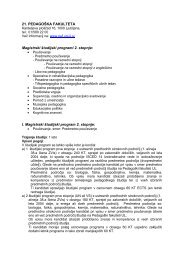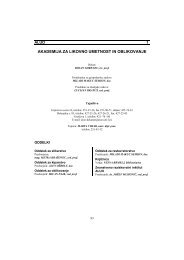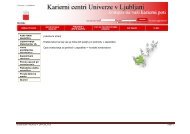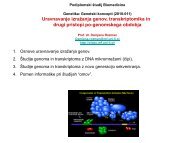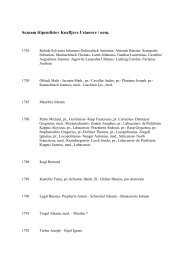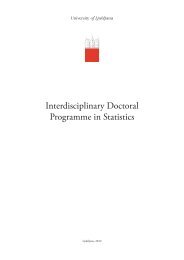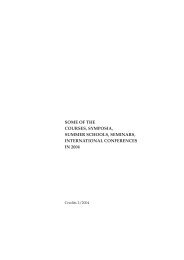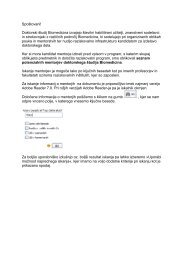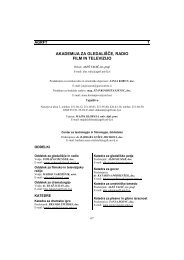Medicinska fakulteta Univerze v Ljubljani 1919–1945 - Univerza v ...
Medicinska fakulteta Univerze v Ljubljani 1919–1945 - Univerza v ...
Medicinska fakulteta Univerze v Ljubljani 1919–1945 - Univerza v ...
You also want an ePaper? Increase the reach of your titles
YUMPU automatically turns print PDFs into web optimized ePapers that Google loves.
in October 1921, emphasizing that although there is a Faculty of<br />
Medicine in Ljubljana, it only has four semesters and Ljubljana<br />
students will have to continue their study after the first final<br />
exams at other universities, which would impose a heavy social<br />
burden on them� He asked the minister to intervene with the<br />
government so as to open at least the third year� Šerko opposed<br />
the aspiration to have only two medical faculties in the State of<br />
SCS, in Zagreb and Belgrade, and rejected the idea of integrating<br />
the Ljubljana Medical Faculty with the one in Zagreb� He<br />
demanded a solution that would meet national requirements as<br />
well as the state’s interests� He continued fighting for a complete<br />
Medical Faculty in the 1924/25 academic year by sending a<br />
memorandum to the education minister in Belgrade and the<br />
university rector, demanding the opening of a fifth semester on<br />
the grounds that examinations of the second part of the first final<br />
exam were normally taken in the fifth semester� This demand was<br />
supported by the current rector Dr Karel Hinterlechner in his<br />
article published in Ljubljanski Zvon�<br />
Development in the Second Decade and<br />
Faculty Expansion with the Third Year<br />
In its second decade, studies at the Faculty of Medicine continued<br />
to consist of the first four semesters as stipulated in the act on<br />
establishing the university in Ljubljana, which covered lectures<br />
in biology, physics, chemistry, anatomy, histology, embriology<br />
and physiology� Over time, the faculty reinforced its staffing�<br />
From 1930 onward, Valentina Grošelj-Kobe trained with<br />
Professor Plečnik as his assistant prosector� In 1938, she became<br />
an assistant professor at the Anatomical Institute and took over<br />
lectures in topographical anatomy� Dr Milan Capuder joined the<br />
faculty in 1935, first as a trainee assistant and after passing the<br />
state examination at the University of Belgrade as an assistant<br />
at the Anatomical Institute� After Professor Plečnik’s death in<br />
December 1940, by then an assistant professor, he took charge<br />
of the Anatomical Institute� Ladislav Klinc taught chemistry as<br />
a private assistant professor from the winter semester of 1931<br />
onward, became an assistant professor of organic chemistry in<br />
1935 and an associate professor in 1939�<br />
Professor Alija Košir was appointed associate professor in 1935<br />
and full professor of histology in 1939� His assistant between 1930<br />
and 1937 was Dr Hubert Pehani, who was appointed assistant<br />
professor of histology and embriology in 1937� Professor Albin<br />
Seliškar was promoted to associate and full professor in 1939 and<br />
August 1945, respectively�<br />
Dr Pavel Grošelj refused his nomination as associate professor<br />
in 1931 for financial reasons and stayed a secondary school and<br />
university teacher for the rest of his life� His death in 1940 raised<br />
124<br />
the issue of his successor� The faculty at first offered to employ Dr<br />
Boris Zarnik, full professor of biology, histology and embriology<br />
at the Zagreb Faculty of Medicine, who accepted and taught<br />
biology in Ljubljana for one year� Further collaboration was<br />
prevented by the war� After that, the faculty entrusted the biology<br />
lectures and the management of the Biological Institute to Dr<br />
Hubert Pehani�<br />
With his rounded personality and professional dedication,<br />
Professor Janez Plečnik felt that his young Medical Faculty<br />
students should also gain knowledge about the tradition of<br />
medicine, its roots, philosophical foundations and historical<br />
background, and needed to understand the course of the history<br />
of medicine� It was his idea and initiative to introduce the history<br />
of medicine as a subject at the faculty� In 1934, the Faculty Council<br />
of the Medical Faculty, while aware that the faculty only had four<br />
semesters and had long been threatened to be abolished, added<br />
the new subject to the curriculum and assigned it to Ivan Pintar<br />
along with the post of part-time lecturer, who became a private<br />
assistant professor in 1939� Dr Ivan Matko, chief physician at the<br />
state hospital in Ljubljana, was a part-time lecturer in internal<br />
propaedeutics from 1936 until his death in 1939� Dr Božidar<br />
Lavrič became a part-time lecturer in surgical propaedeutics in<br />
1936 and in 1938 he was tenured as a private assistant professor<br />
of topographical anatomy, read by third-semester students�<br />
On 28 June 1930, a new Act on Universities was passed, applicable<br />
to all Yugoslav universities, which in Article 51 preserved the<br />
Ljubljana Medical Faculty with only four semesters� Numerous<br />
interventions by Professor Šerko, then rector of the Ljubljana<br />
University, and Dean Kansky in the highest forums were in vain;<br />
the ministry even threatened to lower the faculty’s credits� This also<br />
sparked off mass student demonstrations between 1931 and 1933,<br />
featuring mostly technical and medical students led by left-wing<br />
students, where they expressed, among other things, a demand for<br />
an integral university and protest against the university act and<br />
the new medical decree� In 1932, the Faculty Council approved<br />
the draft faculty decree of the Ljubljana Medical Faculty which<br />
had been formulated in 1931 in agreement with the Belgrade and<br />
Zagreb faculties� It provided for a complete Faculty of Medicine<br />
and also laid down some student restrictions regarding the order<br />
of taking examinations�<br />
Once the university act and general university decree were passed<br />
in 1934, the struggle for the Faculty of Medicine’s completion<br />
intensified� A demand for the establishment of a fifth semester<br />
was voiced at Faculty Council meetings in 1934 and, the next<br />
year, also a demand for the classification of the posts of part-time<br />
lecturers in pathology, internal and surgical propaedeutics and<br />
oncology, which were required for the fifth semester� The early<br />
movement for the completion of the faculty initiated by students



